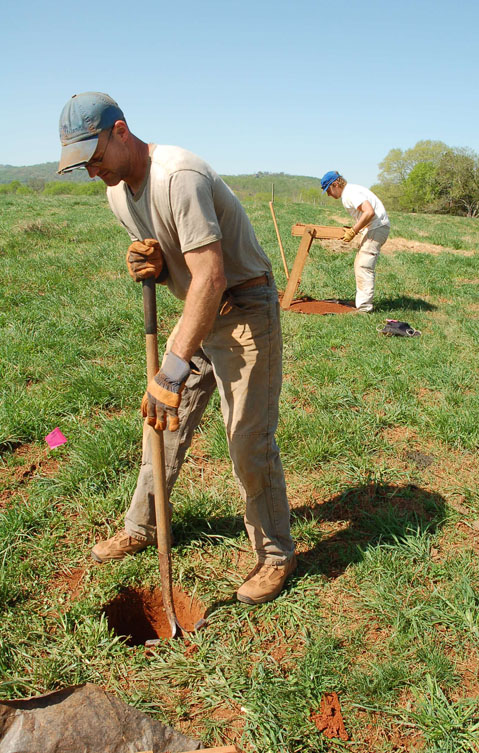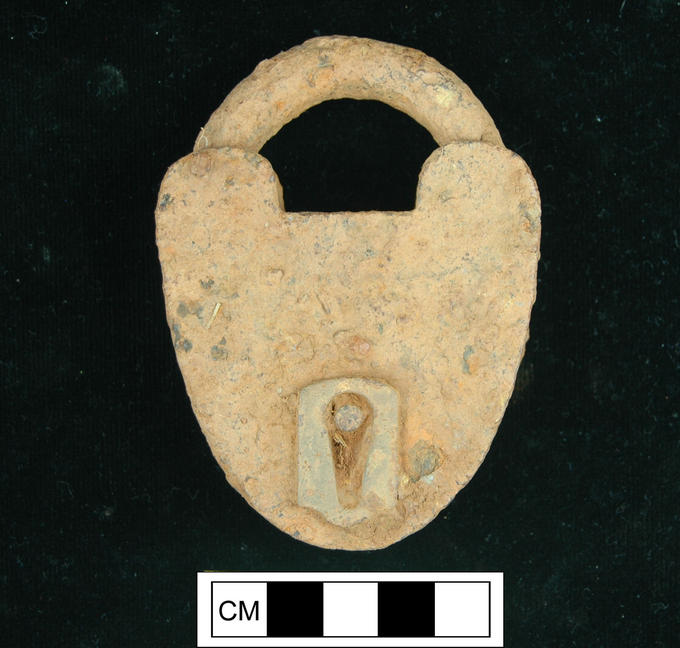
New Archaeological Discoveries at Tufton
Over the past two months, Monticello’s archaeologists have discovered two previously unknown archaeological sites that were once the homes of enslaved people who lived at Tufton, about a mile and a quarter east of Jefferson’s mountaintop mansion. Our preliminary assessment of the artifacts indicates that the earlier of the two sites was occupied in the first few decades of the nineteenth century, probably by enslaved field laborers who worked on the Tufton farm. Tufton was one of four quarter farms that comprised Jefferson’s Monticello Plantation.
This site also contains artifacts that date from the mid to late-nineteenth century. This indicates that after Jefferson’s death and the sale of his slaves to pay his debts, the site was occupied by slaves belonging to Tufton’s subsequent owners, the Macons, who acquired the tract in 1833. The Macons built the Greek-revival style brick house that still stands on the property today. At his death in 1851, Colonel Thomas Macon was among Albemarle’s wealthiest farmers - thanks to the labor of his 46 slaves. The artifacts recovered from this second newly discovered site date from the mid through late-nineteenth century. This later site also contains above-ground remains of at least two houses: A stone foundation and a brick chimney stack.
We are excited about the new discoveries. The Jefferson-era remains on the earlier site give us an opportunity to assess how the material lives of enslaved field hands living on the outlying Tufton quarter farm compared to the lives of two other segments of the Monticello slave community: Field hands who lived and worked on the slopes of Monticello Mountain and domestics and artisans living on Mulberry Row. Secondly, the two later nineteenth-century scatters offer the possibility of studying how the material lives of slaves changed from Jefferson’s time up until the Civil War, and then again after emancipation.
Both sites are what archaeologists call “palimpsests” after the ancient Latin word for a wax tablet on which letters have been incised, then erased, and then written on again, with traces of the original letters still showing beneath the new ones. Understanding Tufton’s newly discovered artifact palimpsests will require cataloging the artifacts and using statistical techniques to analyze the spatial patterns in temporally-sensitive ceramic types. This will allow us to distinguish which parts of the site were occupied at different periods. That work should be complete in a month, so check back here for updates!
Significant Jefferson-era artifacts recovered during the recent survey work include a padlock, which matches one found on Mulberry Row, a glass bead, a slate pencil, a metal coat button, along with scores of datable ceramic sherds in refined English earthenwares and some Chinese porcelain. The sites are large. The earlier artifact scatter measures about 875 by 400 feet while the later one is about 750 by 200 feet. Our initial hypothesis is that they represent multiple, widely spaced single-family houses.
The new research at Tufton is part of an ongoing research initiative: The Monticello Plantation Archaeological Survey. Begun in 1997, the Plantation Survey is an ambitious, multi-disciplinary project, designed to document and explain the settlement and land-use history of the more than 2000-acres comprising the core of Jefferson’s Monticello and owned by the Thomas Jefferson Foundation (TJF) today. The Survey relies on shovel test pits (STPs), dug on a 40-foot grid, to find archaeological sites. So far, Monticello’s archaeologists have dug roughly 20,000 STPs across 600 acres. We have covered about 64 of Tufton’s roughly 500 acres, with a total of 2800 STPs.
Documents indicate that there are many more exciting discoveries to be made at Tufton, including the locations of houses of slaves and overseers from the mid-eighteenth century when the property was farmed by Thomas Jefferson’s father, Peter, and from the late-eighteenth century, when Thomas Jefferson assumed management of the property. In addition, there are surely more undiscovered early-nineteenth century sites. In last year’s survey work at Tufton, archaeologists discovered a small late–eighteenth century site, adjacent to the Macon’s ante-bellum mansion. Jefferson’s survey plats reveal that Elizabeth Hemings, the matriarch of Monticello’s famous Hemings family, lived there in the early 1790’s. In addition, the back yard of the mansion contains a large scatter of early-19th century ceramics, which are likely the result of occupation by tenants, including Jefferson's grandson, Thomas Jefferson Randolph.





